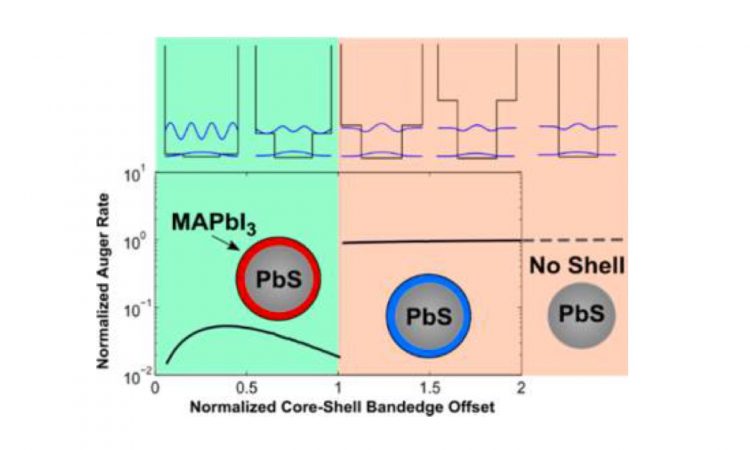| Title: | Small-Band-Offset Perovskite Shells Increase Auger Lifetime in Quantum Dot Solids |
| Authors: | Rafael Quintero-Bermudez, Randy P. Sabatini, Marc Lejay, Oleksandr Voznyy, and Edward H. Sargent |
| Publication Info: | ACS Nano, 2017, 11 (12), pp 12378-12384 DOI: 10.1021/acsnano.7b06363 |
Lasers! Everyone thinks they’re awesome – pew pew, just like in Star Wars, right? The reality is that LASERs (the acronym stands for Light Amplification by Stimulated Emission of Radiation) aren’t just futuristic weapons; they have a myriad of useful applications from communications technologies to computers and biology. Some of the most interesting applications involve using quantum dots to create a continuous-wave laser emitting in the near infrared. Using these quantum dot lasers, scientists can take images of biological processes occurring in live cells! However, there are still improvements to be made; the authors of this work discuss one way to address the efficiency of lasers made from quantum dots.
Quantum dots are nano-sized crystals that are so small they are quantum confined: this means that the electrons inside the quantum dot have discrete energy levels. We can describe these energy levels using wavefunctions (which describe the likelihood that an electron will be at a certain place at a given time). By changing the size of the quantum dot, or by adding a “shell” of a different material on the outside of the quantum dot, we can change how these wavefunctions look and, therefore, how the electrons interact with the quantum dot’s surroundings.
This is particularly important for an application like a laser, involving several layers of close-packed quantum dots. To achieve lasing, a majority of the quantum dots must be “excited”, or have electrons promoted to higher energy levels. The excited electrons can then recombine, emitting radiation (Figure 1 (a)). However, closely packed quantum dots can interact, causing these excited electrons to decay through a process called diffusion-assisted Auger recombination and negatively affecting the efficiency of the laser. In addition, intradot Auger recombination processes can also lead to fewer excited molecules and lowered efficiency. Finally, defect sites on the quantum dot surface can “trap” one of the charges, preventing radiative recombination (Figure 1 (c)).
Intradot Auger recombination can be seen in Figure 1 (b), where two electrons are excited in the same quantum dot. One electron recombines with a positive charge (hole), transferring its energy to the second electron instead of emitting it as radiation. Since this recombination process does not result in radiative emission, it detracts from the overall efficiency of the laser.
Figure 1 (d) shows a schematic of diffusion-assisted Auger recombination: in the quantum dot at the arrow’s beginning, an electron (blue) has been excited to a higher energy level. The arrow shows diffusion of this charge between nearby quantum dots until the charge reaches another quantum dot with an excited electron. One electron recombines with the positive charge (red), transferring its energy to the second electron and exciting it further, but there is again no emission of light and therefore no lasing. This paper addresses the problem Auger recombination by engineering the wavefunctions of the quantum dot using different shell thicknesses.

The authors of the paper first used mathematical modeling to describe the effect on the Auger recombination rate of adding a shell of a perovskite material of different thicknesses to the outside of the quantum dot. By adding a shell of different thickness, they change the theoretical offset, or energy difference between the electron’s energy level in the quantum dot core and in the surrounding shell. This offset between the electron energy levels affects the wavefunction of the electron (or the probability of finding that electron in a certain region of space). A larger offset means that the electron is more confined inside the quantum dot, as shown in Figure 2. They also tested their model for a shell of another inorganic material, cadmium sulfide (CdS), with a larger core-shell electron level offset (middle of Figure 2) and for no shell. The results show that the Auger rate of recombination is minimized when the electron wavefunction is the least confined, which is achieved at very low core-shell electron level offsets (left of Figure 2).

The authors then made films of quantum dots with the various shells and confirmed the results of their models using experiments. By exciting the quantum dot films with different powers of light and measuring how long the electron took to decay (using a technique called transient absorption spectroscopy), the authors were able to experimentally measure the different rates of Auger recombination for each type of film: with perovskite shells, CdS shells, or no shell. Again, the perovskite shells on the quantum dots proved to yield the slowest rates of Auger recombination, making them the most promising structure for applications in lasers.
The idea of ubiquitous lasers has been around in science fiction for decades now – with new studies like this, we’re taking small steps towards making that a reality. Pew pew!

